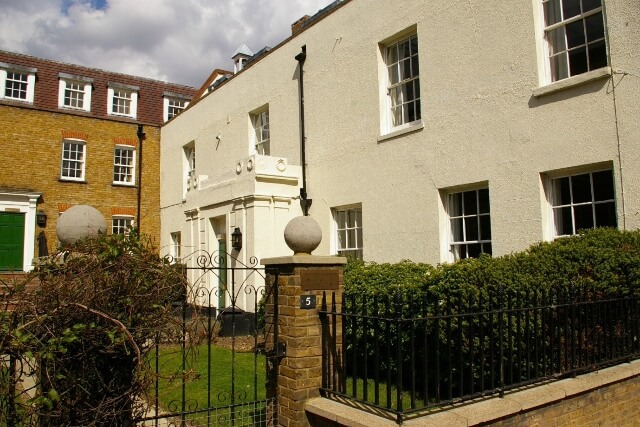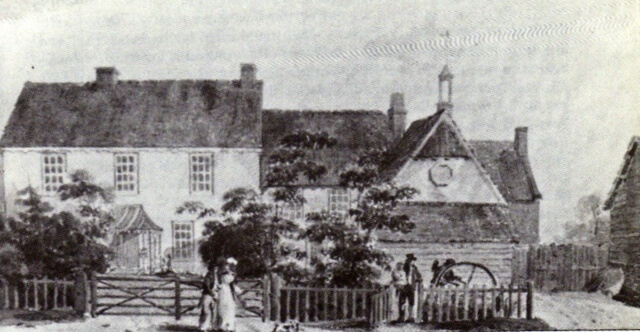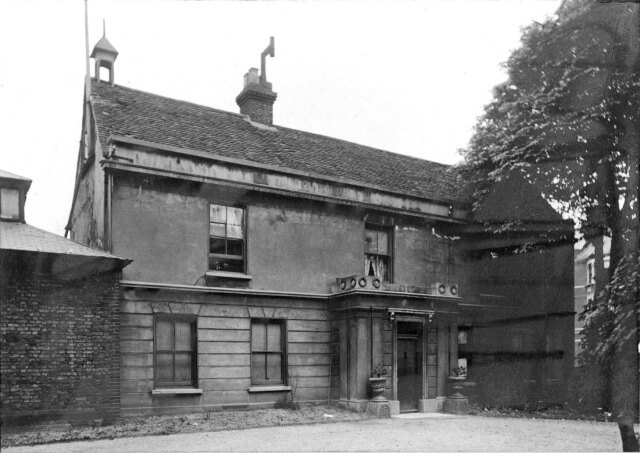We continue the series on Lost Houses of the Hornsey area with this important Stroud Green addition.

There is not much left of Stapleton Hall, but what there is became a listed monument in 1986 and now forms part of a complex of flats on Stapleton Hall Road in Stroud Green. Not far away on Crouch Hill the Stapleton Tavern uses the same name as the house and road.
The myth associated with Stapleton Hall
The name Stapleton Hall seems to have first appeared in the London Evening Post in 1764. The following year Beata Rogers was listed as the proprietor of an ale house of that name in Stroud Green. Beata was the wife of the master of the Green Man alehouse who fell from his horse in 1759 as he was riding through Islington and died immediately. The Green Man at Stroud Green was used occasionally by a gentlemen’s drinking club, the Ancient Corporation of Stroud Green. By 1769 the name of the alehouse had changed to Stapleton Hall. In 1784 the Gentleman’s Magazine stated that Stapleton Hall took its name from having been the property and residence of Sir Thomas Stapleton, a myth that was frequently repeated.
Who were the Stapletons?
Sir Thomas Stapleton was the son of Sir William Stapleton and the great-grandson of the first Sir William Stapleton who was appointed Deputy Governor of Montserrat and Captain General of the Leeward Islands 1672 -1685. He was created a baronet in 1679, and became a wealthy man through his ownership of, or interest in, sugar plantations on four West Indies islands; Monserrat, St Kitts, Antigua, and Nevis. After he died in 1686, the wealth passed down through the generations and different lines of the Stapleton family with Nevis going to Sir William, the fourth Baronet and Thomas’ father.
Sir William, born in 1698 in Nevis, succeeding to the baronetcy in 1699, came to England with his mother for his education, matriculating at Oxford in 1714. He married Catherine Paul in 1724, co-heiress daughter of Sir William Paul of Braywick. Catherine’s dowry gave Sir William Stapleton possession of Greys Court, Oxfordshire, also the house and farmland at Stroud Green. This land had previously been held by the descendants of John Draper who died in 1576, descending through his sons Thomas, Robert, and Roger who died in 1659.The house and land was eventually in the hands of Robert Draper’s grandson, Sir Thomas Draper, Baronet of Sunninghill, Berkshire (d.1703) when it passed to Sir William Paul. More of Thomas Draper below.
Sir William Stapleton and his wife Catherine established themselves at Greys Court where Thomas was born in 1727. Sir William held the land at Stroud Green until he died in 1741. Catherine then held it until her death in 1753, after which time it was held by her son Sir Thomas Stapleton who died in 1781. After his grandmother, Lady Frances Stapleton, died in 1746, Sir Thomas set up home in her house at Stoke Green, near Windsor. During all this time the house and farmland at Stroud Green was occupied by tenant farmers and neither Sir William nor Sir Thomas ever lived there.
Description of Stapleton Hall in the 18th century
The house, dating from the 16th century when John Draper held it and the surrounding land, was developed by Sir William Stapleton in 1735. By 1773 it was described as a large dwelling house with suitable out buildings on a grass farm consisting of 81 acres, known as Stapleton Hall Farm. A few years later it was again described as a good farmhouse with barns, stables and all suitable offices.
19th century history of the house
Before he died Sir Thomas sold the house and land and in 1776 the estate was held by Joseph Lucas of Trinity Place, Charing Cross. When he died in 1807 it passed to his nephew John Lucas who held it at the time of the Hornsey Enclosure Act 1813. By 1823 William Lucas was in possession and began to make improvements suitable for a gentleman farmer and he later converted it into two houses.

The mysterious initials in the house
John Nelson, in his history of St Mary’s Parish, Islington (1811), wrote that Sir Thomas Stapleton of Stapleton Hall was of, ‘an antient family remarkable for the number of eminent men it has produced. In the building are his initials with those of his wife, and the date 1609’. The Victoria County History (1980) elaborates on this and states that these initials appear on the date stone above the door and on internal panelling. However, since Sir Thomas was born in 1727 neither of these statements are correct.
The initials were recorded as being part of an oak panelled room in 1909. Luckily a piece of wooden panelling bearing the date 1609 and the initials DTS (now in Bruce Castle Museum) was salvaged from Stapleton Hall in the 1980s when the building was converted into flats by Lovell Homes.
The left hand end of the panel is missing and the initials DTS make up a triangle above the date within some poor quality ornamental carving. In accordance with other examples other examples the initial at the apex usually represents the family name and the lower left initial the name of the principal man. So an interpretation should be that TD is Thomas Draper and S is his wife Sarah. The memorial to Thomas Draper of Stroud Green in the old church of St Mary, Islington, shows he died in 1611.

The demise of the Stapleton Hall as a farm
By 1861 a farmer, Charles Turner, the last resident, had reunited the two houses as a single house but when Stapleton Hall Road was created in the 1870s part of the house was demolished. Charles Turner moved to Womersley House at the top of Mount Pleasant in 1886 when he leased the building to the local Conservative Party as a club-house. Since then, the remnant of the house has been remodelled and adapted, but the early 19th century porch survives as a Grade II listed building and can be seen on the frontage to the right-hand block of flats at 5 Stapleton Hall Road.
Website editor’s note
For more detail of the history of Stapleton Hall and its ownership see John’s article in HHS Bulletin 51 (2010) which can be purchased through this website.
Image credits
John Hinshelwood